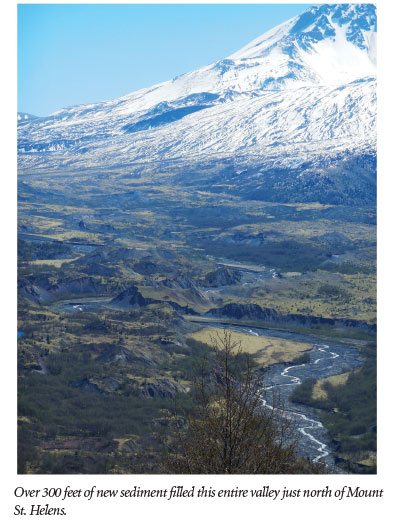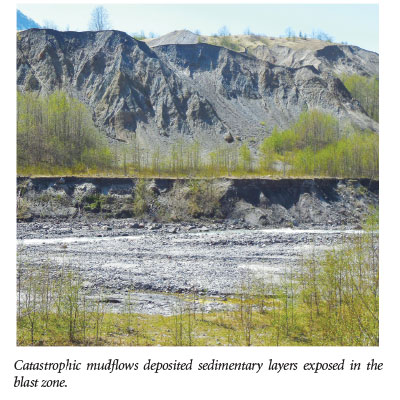 Mount St Helens volcano went off in May of 1980 and it is reputed to have formed geological sedimentary layers in a matter of hours. There is a visitor centre on highway 504, the main road leading to the volcano from the west. It is run by Creationists – go to http://mshcreationcenter.org/7ws1/) but the story can be accessed at www.icr.org/article/8810 … which is also a Creationist web site, but one that is not afraid of delving into catastrophism.
Mount St Helens volcano went off in May of 1980 and it is reputed to have formed geological sedimentary layers in a matter of hours. There is a visitor centre on highway 504, the main road leading to the volcano from the west. It is run by Creationists – go to http://mshcreationcenter.org/7ws1/) but the story can be accessed at www.icr.org/article/8810 … which is also a Creationist web site, but one that is not afraid of delving into catastrophism.
Why are Creationists interested in Mount St Helens? It is purported to show that sedimentary layers can be laid down quickly – virtually in a twinkle of an eye. As such, it is supposed to be evidence that shows the stratigraphic record was not a matter of millions and millions of years, but the Earth could be much younger than secular science would declare. Settled science probably finds Mount St Helens an inconvenient fact – but its hard to tell as they don't say much about the sedimentary time scale as recorded in the aftermath of the volcano. That means we are all being cheated, as dialogue must be preferable to simply ignoring the observations.
The web site is useful if you can wade into it without taking much notice of the Flood narrative as everything is interpreted from a Biblical angle (or rather, from the angle of Young Earthers). Noah and the Flood take pride of place – which is not everyone's cup of tea. However, there is also some good information available, material that mainstream does not adequately address.
 Steam, ash, polarised rocks, pyroclastic flows, and most importantly, the mud flows. Mudstone is a common sedimentary rock that is found in all manner of locations. For example, on the Jurassic coastline of Dorset in southern Britain.
Steam, ash, polarised rocks, pyroclastic flows, and most importantly, the mud flows. Mudstone is a common sedimentary rock that is found in all manner of locations. For example, on the Jurassic coastline of Dorset in southern Britain.
Mount St Helens erupted after a bulge of magma built up on the north side of the peak. The bulge gave way in a giant landslide, releasing hot pressurized fluid, steam and ash, which created a debris flow that filled the Toutle River valley with over 300 feet of instant sediment. Material was also blown into the sky by the force of the explosion and landed in heaps, dumps, or humps, that have become small hillocks, or hummocks.
In March of 1982 another eruption episode melted snow on the mountain and caused mud and water to gouge a way through the two year old deposits. The author then says that catastrophic events can clearly explain some geological features, not just the scenario around Mount St Helens. The 1980 mud flows deposited sediments that hardened into a clearly defined layer of sedimentary rock within just 2 years.
PS … lava with a high silica content continued to ooze out periodically right up to 1986. Ten years later some of the 1986 lava was sent to a laboratory to be dated by the potassium-argon methodology. It gave results of 340,000 to a couple of million years – yet the rock was just ten years of age. Obviously, other factors are involved but it does bring into perspective the whole question of dating sedimentary rock layers – which is the inference made by the author. However, geologists don't just rely on a laboratory date. They have a rough idea prior to going to the laboratory of what the date should be – derived from geochronology. The fact that it is a gradualist agenda with an accepted time scale is neither here nor there – the sediments are situated between two point on the chronology and this is what determines the projected date. It then goes to the laboratory – and evidence is sought to confirm that it conforms to the agenda. If it doesn't questions are asked – and no doubt some fudging occurs. There is more fudge in science than in a seaside fudge factory. The sedimentary layer belongs to an era (prior to being dated) as it is wedged between two other rock strata (that already have a place in geochronology). The sequence is more important than the date itself. We may never know the true date of a rock strata and uniformitarianism with its millions and billions of years is difficult to imagine. The dating methods are designed to prop up the gradualist ediface – and are not an independent arbiter. For example, if a date is produced too young for the rocks above them (already dated and positioned) the dates are rejected, and if they are too old, older than the rocks below them, that is also a case for rejection and another dating method is employed – as sometimes occurs. You would have to trawl around and find out what the mainstream response was to the high dates achieved for the ten year old lava as they are likely to have responded in some kind of way.
